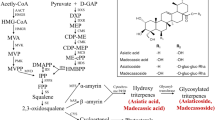Abstract
Plant-derived natural products have been and will continue to be valuable sources. Elicitors have been employed to modify cell metabolism in order to enhance the productivity of useful metabolites in plant cell/tissue cultures. In this study, several elicitors were used to improve the productivity of useful metabolites and to reduce culture time for archiving high concentration inP. ginseng hairy root cultures. The addition of chitosan, chitosan oligosaccharide and alginate oligosaccharide to the culture ofP. ginseng hairy roots caused growth to be inhibited with the increase in elicitor concentration. The usage of the chitosan elicitor andd-glucosamine caused a slight decrease in hairy root growth, whereas total ginseng saponin accumulated slightly with the increase in elicitor concentration. When gel beads were added to the culture medium at the initial period, hairy root growth was enhanced. The maximum growth was 1.35 times higher than that of the control at 1% (w/v). Total ginseng saponin content decreased due to the addition of alginate beads. This would result in consistent diffusion of lower levels of calcium ions during the culture period that promotes biomass growth.
Similar content being viewed by others
References
Banthorpe, D. V. (1994) Secondary metabolism in plant tissue culture: Scope and limitations.Nat. Prod. Rep. 303–328.
Lee, J. H., N. H. Loc, T. H. Kwon, and M. S. Yang (2004) Partitioning of recombinant human granulocyte-macrophage colony stimulating factor (hGM-CSF) from plant cell suspension culture in PEG/sodium phosphate aqueous two-phase systems.Biotechnol. Bioprocess Eng. 9: 12–16.
Lee, S. Y., J. M. Cho, and D. I. Kim (2003) Stability enhancement of hGM-CSF in transgenicNicotiana tabacum suspension cell cultures.Biotechnol. Bioprocess Eng. 8: 187–191.
Ramachandra R. S. and G. A. Ravishankar (2002) Plant cell cultures: Chemical factories of secondary metabolites.Biotechnol. Adv. 20: 101–153.
Akimoto, C., H. Aoyagi, and H. Tanaka (1999) Endogenous elicitor-like effects of alginate on physiological activities of plant cells.Appl. Microbiol. Biotechnol. 52: 429–436.
Bhagwath, S. G. and M. A. Hjorts (2000) Statistical analysis of elicitation strategies for thiarubrine: A production in hairy root cultures ofAmbrosia artemisiifolia.J. Biotechnol. 80: 159–167.
Akimoto, C., H. Aoyagi, and H. Tanaka (1999) Endogenous elicitor-like effects of alginate on physiological activities of plant cells.Appl. Microbiol. Biotechnol. 52: 429–436.
Kim, J. H., J. H. Shin, H. J. Lee, I. S. Chung, and H. J. Lee (1997) Effect of chitosan on indirubin production from suspension culture ofPolygonum tinctorium J. Fermentation Bioeng. 83: 206–208.
Uozumi, N. and T. Kobayashi (1994) Application of hairy root and bioreactors. pp. 307–338. In: D. D. Y. Ryu and S. Furusaki (ed.),Advances in Plant Biotechnology. Elsevier, NY, USA.
Jeong, G. T., D. H. Park, B. Hwang and J. C. Woo (2005) Comparison of growth characteristics ofPanax ginseng hairy roots in various bioreactors.Appl. Biochem. Biotechnol. 105-108: 493–503.
Natsume, M., Y. Kamo, M. Hirayama, and T. Adachi (1994) Isolation and characterization of alginate-derived oligosaccharides with root growth-promoting activities.Carbohydr. Res. 258: 187–197.
Sudha, G. and G. A. Ravishankar (2002) Involvement and interaction of various signaling compounds on the plant metabolic events during defense response, resistance to stress factors, formation of secondary metabolites and their molecular aspects.Plant Cell Tissue Organ Culture 71: 181–212.
Author information
Authors and Affiliations
Rights and permissions
About this article
Cite this article
Jeong, GT., Park, DH. Enhancement of growth and secondary metabolite biosynthesis: Effect of elicitors derived from plants and insects. Biotechnol. Bioprocess Eng. 10, 73–77 (2005). https://doi.org/10.1007/BF02931186
Received:
Accepted:
Issue Date:
DOI: https://doi.org/10.1007/BF02931186




